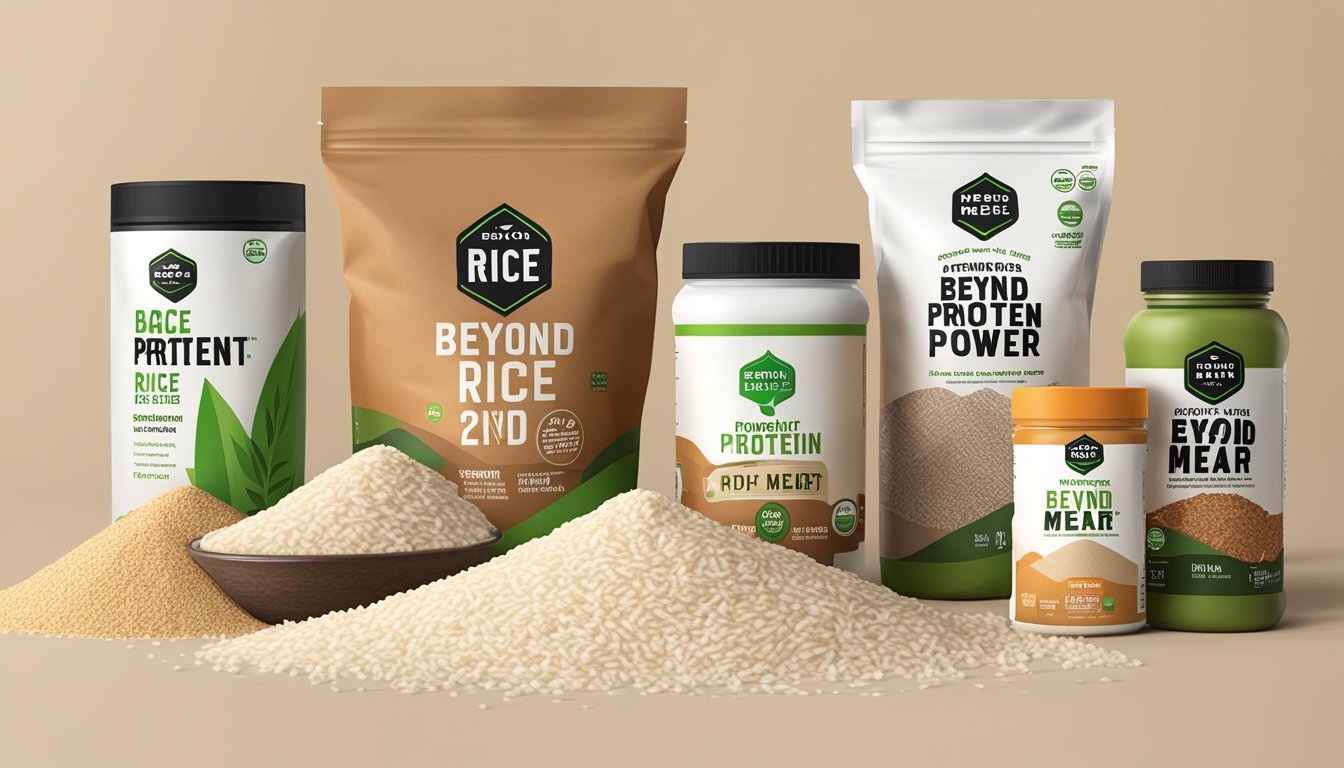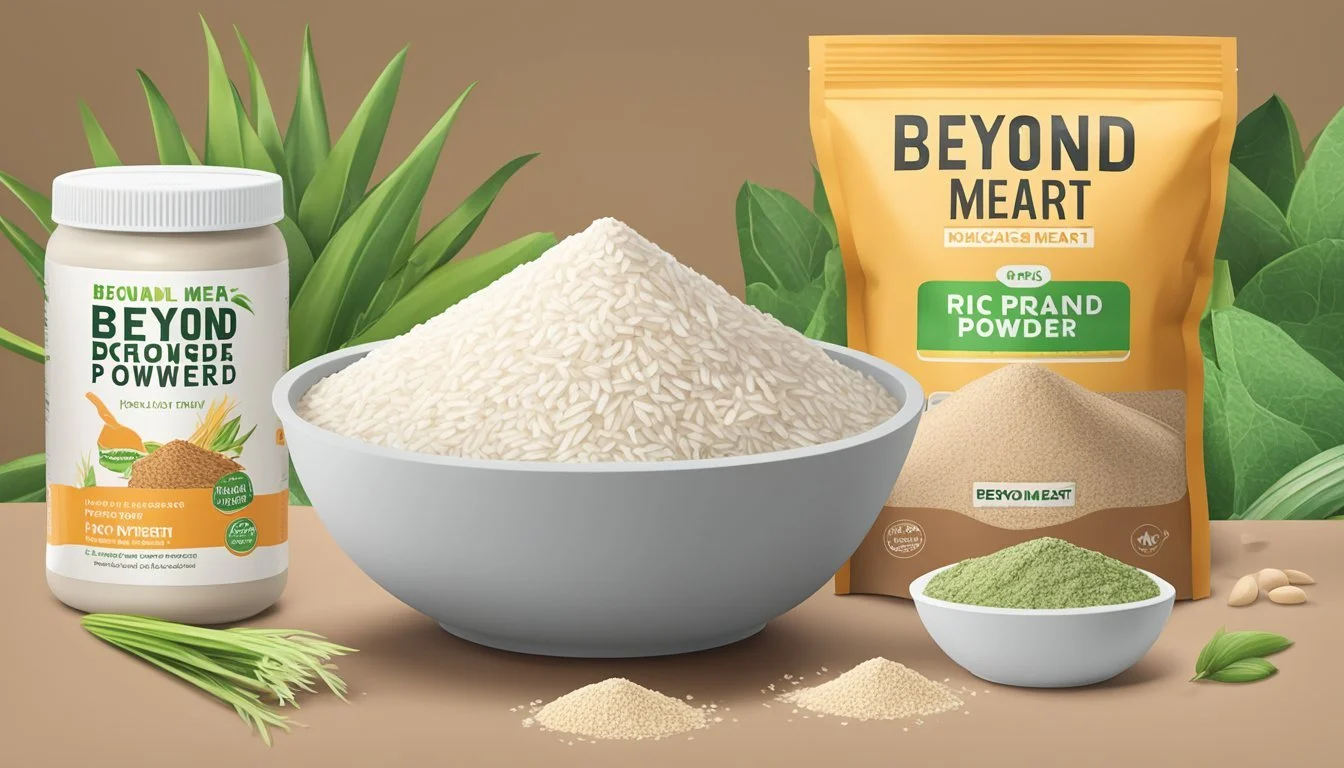Exploring Alternative Protein Sources
The Role of Rice Protein Powder in Beyond Meat Products
The demand for alternative protein sources has surged as consumers become more environmentally conscious and seek sustainable dietary options. One notable player in the plant-based protein market is Beyond Meat, known for its innovative use of various protein sources to mimic the taste and texture of animal meat. An essential ingredient in their product range is rice protein powder, chosen for its nutritional benefits and functional properties.
Rice protein powder is a versatile and hypoallergenic option that fits well within Beyond Meat’s product formulations. It not only helps in achieving the desirable texture and flavor of their plant-based meats but also provides essential amino acids that contribute to a balanced diet. Incorporating rice protein powder allows Beyond Meat products to address both dietary requirements and sustainability concerns effectively.
As the plant-based food industry continues to expand, rice protein powder is likely to play a pivotal role in developing more innovative and nutritious alternatives to traditional meat products. The growing popularity of Beyond Meat showcases the potential for rice protein powder to meet the evolving needs of consumers and the environment, making it a vital component in the future of food production.
The Rise of Alternative Protein Sources
Alternative protein sources have gained momentum due to an increasing global population, the health benefits they offer, and their potential to promote sustainability. This section delves into the key drivers behind their popularity, the nutritional comparison between plant-based and animal proteins, and the role of innovation in the food industry.
Drivers of Alternative Protein Popularity
The popularity of alternative protein sources is driven by several factors. One major driver is the growing awareness of the environmental impact of traditional meat production. Livestock farming significantly contributes to greenhouse gas emissions, deforestation, and water use.
Health considerations also play a crucial role. Many consumers seek proteins that are lower in saturated fats and cholesterol. Plant-based proteins meet these criteria and are often rich in fiber and essential nutrients. Economic factors also influence this shift, as meat prices fluctuate and plant-based alternatives become more cost-effective.
Comparing Plant-Based and Animal Proteins
When comparing plant-based and animal proteins, it's essential to look at their nutritional profiles. Animal proteins are complete proteins, providing all essential amino acids. However, they can be high in unhealthy fats and cholesterol.
Plant-based proteins, such as those from legumes, nuts, and seeds, might lack one or more essential amino acids. However, they offer other health benefits, like higher fiber content and lower levels of unhealthy fats. Research shows that a well-balanced diet combining different plant proteins can meet all essential amino acid requirements while supporting health and sustainability.
Role of Innovation in Food Industry
Innovation in the food industry is crucial in meeting the rising demand for alternative proteins. Techniques like precision fermentation and cell-based meat production are being developed to create protein sources that mimic the taste and texture of traditional meats without the associated environmental impact.
Startups and established companies invest in research and development to enhance the taste, texture, and nutritional profile of plant-based proteins. Products such as Beyond Meat heavily rely on these innovations, using ingredients like pea protein and rice protein powder to create meat substitutes that appeal to mainstream consumers.
Collaboration between scientists, food technologists, and manufacturers is essential in pushing forward these innovations. This joint effort helps address the challenges of scaling production while maintaining high quality and affordability.
Understanding Rice Protein Powder
Rice protein powder is derived from rice grains and serves as a plant-based protein alternative. It is known for its beneficial nutritional properties, effective amino acid profile, and relatively straightforward extraction process.
Nutritional Value of Rice Protein
Rice protein powder offers a robust nutritional profile. It is primarily valued for its high protein content, providing an excellent source of plant-based protein for individuals looking to reduce or eliminate animal protein intake. It is also rich in essential amino acids and vitamins such as B vitamins, which are crucial for energy metabolism.
Rice protein powder has modest levels of carbohydrates and fats. Moreover, it contains no gluten, making it suitable for individuals with celiac disease or gluten sensitivity. The low allergenic potential of rice protein powder makes it an accessible option for those with food allergies or intolerances.
Extraction and Processing Technologies
The production of rice protein powder involves different extraction and processing methods to isolate the protein from rice grains. The common methods include enzymatic extraction and wet milling. Enzymatic extraction employs specific enzymes to break down the rice starches, separating the protein efficiently.
Wet milling, alternatively, uses water and mechanical actions to separate the protein. The resulting product is then dried and processed into a fine powder. Both methods aim to maintain the protein's quality and nutritional benefits while ensuring the product’s purity and safety.
Amino Acid Profile and Digestibility
Rice protein is known for its favorable amino acid profile. It contains high levels of essential amino acids like lysine, methionine, and cysteine, which are vital for various bodily functions. Although rice protein powder lacks certain amino acids compared to animal proteins, it complements other plant-based proteins well.
The digestibility of rice protein powder is relatively high, with studies indicating that it is easily digested and absorbed by the body. This makes it an effective protein source for muscle recovery and growth, as well as general nutritional supplementation.
Understanding these aspects of rice protein powder helps position it as a valuable alternative in the realm of plant-based proteins, particularly in products like Beyond Meat.
Beyond Meat Products and Rice Protein
Rice protein is finding its place in Beyond Meat products, particularly for its contribution to meat analogues. It enhances texture and mouthfeel, making plant-based alternatives more appealing to consumers. Product development heavily relies on consumer acceptance, dictating the success of rice protein integration.
Incorporation into Meat Analogues
Rice protein is increasingly incorporated in a variety of meat analogues created by Beyond Meat. Its functional properties help mimic the fibrous texture and amino acid profile typical of traditional meat.
This protein source is favored for its hypoallergenic nature, making it suitable for those with soy and gluten allergies. Leveraging rice protein in formulations assists in achieving nutritional targets while maintaining plant-based product standards.
Texture and Mouthfeel Achievements
The inclusion of rice protein plays a significant role in achieving desirable texture and mouthfeel in Beyond Meat products. This protein helps create a juicy mouthfeel and a firm, fibrous texture similar to ground meat. These qualities are critical for consumer satisfaction.
Rice protein contributes to the moisture retention and bite characteristics of meat analogues. Its fine particle size and functional properties ensure the product retains a desirable texture even after cooking, enhancing the overall eating experience.
Product Development and Consumer Acceptance
The ongoing development of Beyond Meat products incorporating rice protein is driven by consumer demand for healthier and sustainable options. Trials and feedback loops are crucial for refining these products to meet consumer expectations.
Rice protein’s nutritional benefits, coupled with its functionality, make it a promising ingredient. However, consumer acceptance remains pivotal. Through marketing and education, Beyond Meat aims to address any skepticism and emphasize the benefits of rice protein in their plant-based offerings.
Health Implications of Rice Protein in Diet
Rice protein powder is a notable component in alternative protein products, contributing to health benefits such as improved nutrient absorption and lipid profile improvements. Specific health benefits include enhancing protein and amino acid absorption, positively impacting cholesterol levels, and supporting healthier diets.
Protein and Amino Acid Absorption
Rice protein is rich in essential amino acids, which are the building blocks of protein synthesis in the body. It contains high amounts of lysine, often lacking in other plant-based proteins. The absorption rate of rice protein is comparable to whey protein, ensuring efficient utilization by the body.
Given its hypoallergenic nature, rice protein is an excellent choice for individuals with sensitivities to soy or dairy. It also has a balanced profile of both essential and non-essential amino acids, supporting muscle maintenance and repair.
Impact on Cholesterol and Lipid Profile
Including rice protein in the diet may contribute to better lipid profiles. Studies have shown that consuming rice protein can lower total cholesterol and LDL (low-density lipoprotein) levels. This improvement could be linked to the presence of peptides in rice protein that interact positively with cholesterol metabolism.
Additionally, rice protein's high fiber content aids in the reduction of LDL cholesterol. These factors make it a valuable component for cardiovascular health and lowering the risk of heart disease.
Rice Protein and Healthy Diets
Rice protein supports a healthy diet by providing a significant source of plant-based protein, essential for vegetarians and vegans. It is often integrated into beyond meat products to enhance their nutritional profile without compromising flavor or texture.
Moreover, rice protein's role in suppressing proinflammatory cytokines is beneficial for those on high-fat or high-carbohydrate diets. By reducing inflammation, rice protein helps maintain overall health and can assist in managing diet-induced health issues.
In summary, incorporating rice protein into the diet can offer multiple health benefits, from improved protein absorption to better lipid profiles and supporting a balanced, nutritious diet.
Environmental and Economic Considerations
Rice protein powder in Beyond Meat products presents both environmental and economic benefits. Key areas include the sustainability of rice as a crop and the cost-effectiveness in production and market dynamics of alternative proteins.
Sustainability and Environmental Impact
Rice, as a crop, has a relatively low environmental footprint. Unlike livestock, rice cultivation emits fewer greenhouse gases. Additionally, it requires less water and land compared to the vast resources needed for meat production.
Growing rice generates less methane than other staple crops like paddy rice used for direct consumption. This makes rice protein powder a more sustainable alternative. Furthermore, the transition to plant-based diets driven by rice protein helps reduce deforestation and biodiversity loss, addressing crucial environmental concerns.
Cost of Production and Market Trends
The production cost of rice protein powder is moderately lower than other traditional protein sources. Its affordability is partly due to the abundant global rice supply. Economies of scale in rice cultivation and processing contribute to keeping costs down.
Market trends indicate a growing demand for alternative proteins. Consumers are increasingly health-conscious and environmentally aware. This shift boosts the market share of plant-based products like Beyond Meat. Additionally, as technology advances, production costs are expected to decrease further, making rice protein powder an even more viable option.
Comparative Analysis with Other Protein Sources
This section explores how rice protein powder in Beyond Meat products compares against popular alternatives. The analysis covers plant-based and unconventional protein sources, highlighting key differences in nutritional content, environmental impact, and commercial viability.
Pea Proteins and Soy Proteins
Pea proteins and soy proteins are commonly used in plant-based meat alternatives. They are valued for their high protein content and functional properties such as emulsification and gelation.
Pea Proteins:
Nutritional Content: Rich in essential amino acids, though slightly lower in methionine.
Environmental Impact: Relatively low water and land use.
Commercial Use: Widely used due to their neutral flavor and texture.
Soy Proteins:
Nutritional Content: Complete protein profile similar to animal sources.
Environmental Impact: Higher concern due to deforestation and pesticide use.
Commercial Use: Extensive use in various meat analogs, benefiting from its well-established supply chain.
Insect Proteins and Microalgae
Insect proteins and microalgae are emerging as sustainable alternatives, offering high nutrient density and minimal environmental footprint.
Insect Proteins:
Nutritional Content: High in protein and beneficial fats, including omega-3 and omega-6.
Environmental Impact: Low environmental impact; insects require less land, water, and feed.
Commercial Use: Limited by consumer acceptance and regulatory challenges.
Microalgae:
Nutritional Content: Rich in protein, vitamins, and minerals, particularly iron and B12.
Environmental Impact: Highly sustainable; they grow rapidly and can be cultivated in controlled environments.
Commercial Use: Increasing but with challenges in cost and scalability.
Legume Proteins and Nut Proteins
Legume proteins and nut proteins provide diverse nutritional benefits and are staples in various dietary traditions worldwide.
Legume Proteins:
Nutritional Content: Generally high in protein, fiber, and essential nutrients.
Environmental Impact: Nitrogen-fixing properties improve soil health and reduce the need for synthetic fertilizers.
Commercial Use: Commonly used in plant-based meat products due to their affordability and availability.
Nut Proteins:
Nutritional Content: Rich in healthy fats, protein, and antioxidants.
Environmental Impact: Higher water usage, especially for almonds and cashews.
Commercial Use: Used in specialized products due to their distinctive taste and premium positioning.
Each protein source offers unique advantages and challenges when compared to rice protein powder in Beyond Meat products.
Technological Prospection in Protein Alternatives
The field of alternative protein sources has witnessed significant technological advancements and scientific exploration. Important topics include the improvements in processing methods, the evaluation of trends through patent analysis, and the implications of market dynamics.
Advancements in Processing and Extrusion
Processing technologies in alternative proteins play a crucial role in creating plant-based products that mimic the texture and flavor of meat. Extrusion technology is particularly vital, as it transforms protein-rich sources into meat-like structures.
Recent innovations have enabled manufacturers to tweak processing parameters to enhance texture fidelity. Techniques like high-moisture extrusion cooking (HMEC) produce fibrous structures similar to muscle tissues. Accurate temperature and moisture control during extrusion improve protein quality and consistency.
Processing advancements also involve biotechnological methods, such as fermentation, to enrich protein content in plant-based sources. These methods not only improve nutritional profiles but also ensure scalability and cost-effectiveness.
Patents, Biological Science, and Market Trends
Analyzing patents and biological science literature offers insights into the ongoing technological prospection in protein alternatives. Biological advancements have fueled discoveries in novel protein sources like microalgae and insect proteins.
A growing number of patents indicate increased innovation in this field. The food industry has seen a surge in patent filings, reflecting a robust interest in proprietary technologies. The trend has been ongoing since the 1970s, with a significant rise in documented research.
Market trends highlight a rising consumer demand for sustainable and ethical food products. This trend pushes companies to innovate continuously, ensuring that products meet environmental and nutritional standards. Capital investment in enhancing production capacities further accelerates the adoption of alternative protein sources.
Continued research and technological prospection are imperative to meet global food security challenges and cater to a diversifying market.
Challenges and Opportunities for Rice Protein
Rice protein, derived from Oryza sativa, is gaining attention in the plant-based protein market. Exploring its potential involves addressing regulatory challenges, uncovering growth opportunities, and advancing research and development.
Regulatory Issues and Product Safety
Regulatory hurdles for rice protein involve ensuring product safety and compliance with food standards. Agencies like the FDA and EFSA mandate rigorous testing for allergens and contaminants.
Meeting these standards ensures consumer trust and broad market acceptance. Furthermore, production processes must maintain consistency to achieve certification and avoid recalls.
Safety protocols include regular inspections, batch testing, and documentation to comply with regulations. As rice protein is incorporated into more products, adhering to regulations becomes crucial for market growth.
Growth Opportunities in Alternative Markets
The demand for plant-based protein is expanding, with rice protein playing a vital role in alternative markets. Factors driving this growth include the increased interest in vegan and vegetarian diets and rising health awareness.
Rice protein's hypoallergenic properties make it suitable for a wide range of consumers. Potential markets include sports nutrition, weight management products, and allergen-free foods.
Partnerships with food tech firms and investment in marketing can propel rice protein into mainstream use. Expanding geographical markets also presents a lucrative opportunity for this versatile protein source.
Research and Development Perspectives
Advances in research and development are pivotal for enhancing the applications of rice protein. Current research focuses on improving extraction methods to enhance protein yield and functional properties.
Studies are also exploring the bioavailability of rice proteins and their benefits in muscle recovery and gut health. Collaboration between academia and industry accelerates innovation, leading to more nutritious and functional products.
Investing in cutting-edge technologies like enzymatic hydrolysis and fermentation can address taste and texture issues, making rice protein more appealing. Continuous R&D efforts ensure rice protein remains competitive in the evolving plant-based protein market.
Conclusion
The integration of rice protein powder within Beyond Meat products marks a significant innovation in the food industry.
Rice protein, known for its hypoallergenic properties, enhances the nutritional profile of plant-based meats. This ensures a broader consumer acceptance, catering to those with dietary restrictions.
The shift towards sustainable diets is crucial. Beyond Meat's efforts in adopting alternative protein sources contribute to reducing environmental impacts. Traditional meat production is resource-intensive and contributes substantially to greenhouse gas emissions.
Looking at future prospects, the food industry continues to explore and perfect alternative proteins. This not only aims at improving taste and texture but also ensures sufficient protein content.
Rice protein's role underscores the potential held by plant-based alternatives. As consumer demand for sustainable options grows, innovation in this field is likely to expand further.
In conclusion, Beyond Meat's use of rice protein powder exemplifies the strides being made towards healthier and more sustainable food products. Through ongoing research and development, the future of alternative proteins holds promising possibilities for feeding a growing population.











